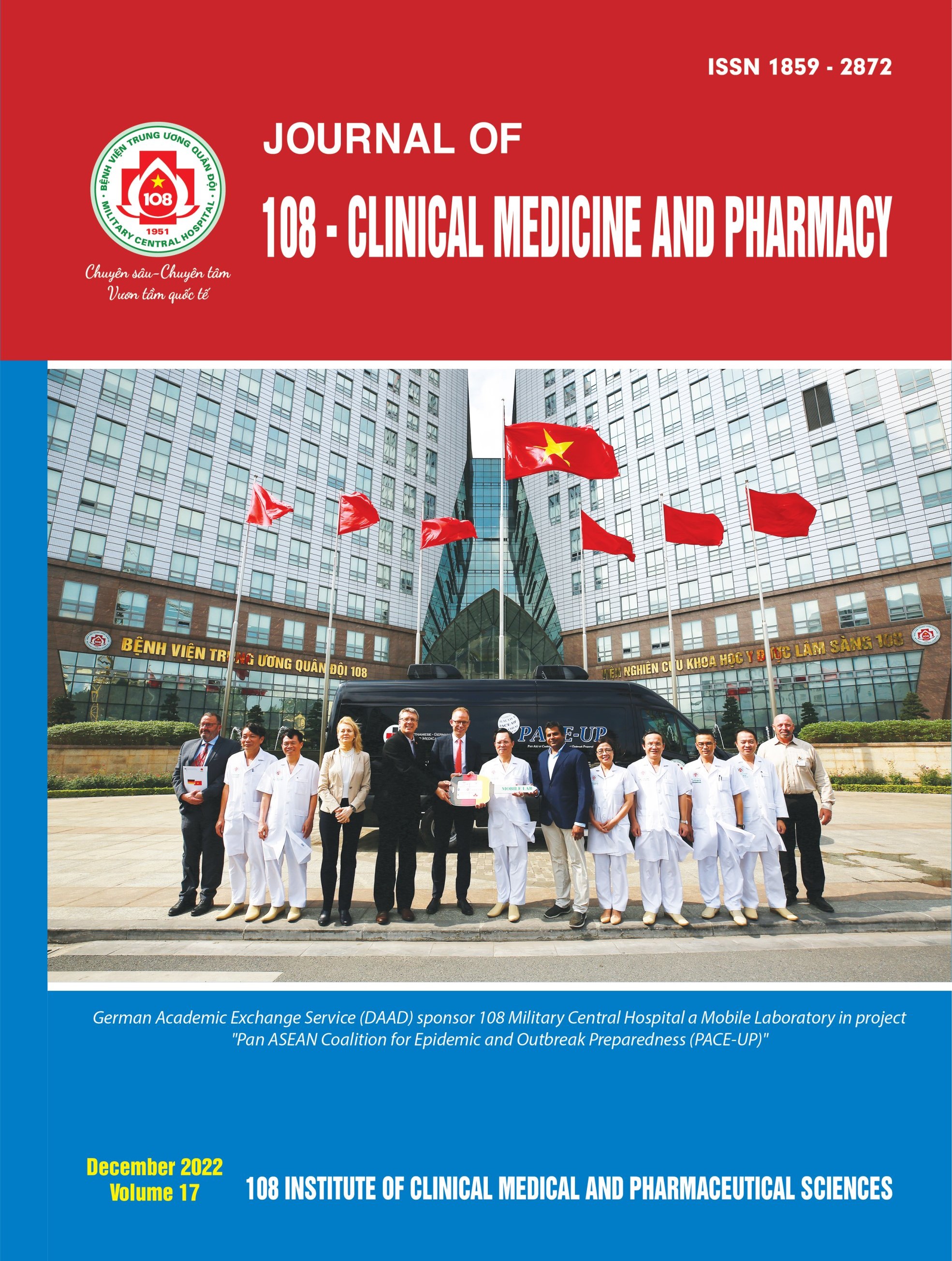Multiple endocrine neoplasia 2A with RET mutation p.Cys380Arg (GRCh38): A case report
Main Article Content
Abstract
MEN 2A is a complex autosomal dominant inherited syndrome characterized by pheochromocytoma (PC), medullary thyroid carcinoma (MTC) and primary parathyroid hyperplasia (PHP). We report a case of 26 years old female offended with bilateral pheochromocytoma, medullary thyroid carcinoma and primary hyperparathyroidism due to multiple endocrine neoplasia type 2A confirmed by RET gene mutation p.Cys380Arg according to the GRCh38 (Genome Reference Consortium Humain Build 38 Organism - 2013) classification. The mutation with a change of amino acid 380 from Cys (Cysteine) to Arg (Arginin) is found in more than one-half of kindreds with MEN2A.
Article Details
References
1. Eng C (2019) Multiple Endocrine Neoplasia Type 2. 1999 Sep 27 [Updated 2019 Aug 15]. In: Adam MP, Everman DB, Mirzaa GM, et al., editors. GeneReviews® [Internet]. Seattle (WA): University of Washington, Seattle; 1993-2023.
2. Wells SA, Pacini F, Robinson BG, Santoro M (2013) Multiple endocrine neoplasia type 2 and familial medullary thyroid carcinoma: An update. J Clin Endocrinol Metab 98(8): 3149-3164.
3. Brandi ML, Gagel RF, Angeli A, Bilezikian JP, Beck-Peccoz P, Bordi C et al (2001) Guidelines for diagnosis and therapy of MEN type 1 and type 2. J Clin Endocrinol Metab 86(12): 5658-5671.
4. Ramundo V, Milone F, Severino R, Savastano S, Di Somma C, Vuolo L et al (2011) Clinical and prognostic implications of the genetic diagnosis of hereditary NET syndromes in asymptomatic patients. Horm Metab Res Horm Stoffwechselforschung Horm Metab 43(11): 794-800.
5. Blake MA, Kalra MK, Maher MM, Sahani DV, Sweeney AT, Mueller PR et al (2004) Pheochromocytoma: An imaging chameleon. RadioGraphics 24(1): 87-99.
6. American Thyroid Association Guidelines Task Force, Kloos RT, Eng C, Evans DB, Francis GL, Gagel RF et al (2009) Medullary thyroid cancer: Management guidelines of the American Thyroid Association. Thyroid Off J Am Thyroid Assoc 19(6): 565-612.
7. Guyétant S, Dupre F, Bigorgne JC, Franc B, Dutrieux-Berger N, Lecomte-Houcke M et al (1999) Medullary thyroid microcarcinoma: A clinicopathologic retrospective study of 38 patients with no prior familial disease. Hum Pathol 30(8): 957-663.
8. Alevizaki M, Saltiki K (2015) Primary Hyperparathyroidism in MEN2 Syndromes. Recent Results Cancer Res Fortschritte Krebsforsch Progres Dans Rech Sur Cancer 204: 179-186.
9. Slitt GT, Lavery H, Morgan A, Bernstein B, Slavin J, Karimeddini MK et al (2005) Hyperparathyroidism but a negative sestamibi scan: A clinical dilemma. Am J Surg 190(5): 708-712.
10. Lal A, Chen H (2007) The negative sestamibi scan: is a minimally invasive parathyroidectomy still possible? Ann Surg Oncol 14(8): 2363-2366.
11. RET Proto-Oncogene - an overview | ScienceDirect Topics [Internet]. [cited 2022 Oct 30]. Available from: https://www.sciencedirect.com/topics/ biochemistry-genetics-and-molecular-biology/ret-proto-oncogene.
12. Nguyen Hai Ha, Nguyen Thi Thanh Hoa, Pham Thi Dung, Nguyen Huy Binh, Nguyen Dang Ton (2020) Genetic testing identifies the potential risk of multiple endocrine neoplasia in a vietnamese family. Vietnam Journal of Biotechnology.
13. Thornton K, Kim G, Maher VE, Chattopadhyay S, Tang S, Moon YJ et al (2012) Vandetanib for the treatment of symptomatic or progressive medullary thyroid cancer in patients with unresectable locally advanced or metastatic disease. Clin Cancer Res; 18(14).
2. Wells SA, Pacini F, Robinson BG, Santoro M (2013) Multiple endocrine neoplasia type 2 and familial medullary thyroid carcinoma: An update. J Clin Endocrinol Metab 98(8): 3149-3164.
3. Brandi ML, Gagel RF, Angeli A, Bilezikian JP, Beck-Peccoz P, Bordi C et al (2001) Guidelines for diagnosis and therapy of MEN type 1 and type 2. J Clin Endocrinol Metab 86(12): 5658-5671.
4. Ramundo V, Milone F, Severino R, Savastano S, Di Somma C, Vuolo L et al (2011) Clinical and prognostic implications of the genetic diagnosis of hereditary NET syndromes in asymptomatic patients. Horm Metab Res Horm Stoffwechselforschung Horm Metab 43(11): 794-800.
5. Blake MA, Kalra MK, Maher MM, Sahani DV, Sweeney AT, Mueller PR et al (2004) Pheochromocytoma: An imaging chameleon. RadioGraphics 24(1): 87-99.
6. American Thyroid Association Guidelines Task Force, Kloos RT, Eng C, Evans DB, Francis GL, Gagel RF et al (2009) Medullary thyroid cancer: Management guidelines of the American Thyroid Association. Thyroid Off J Am Thyroid Assoc 19(6): 565-612.
7. Guyétant S, Dupre F, Bigorgne JC, Franc B, Dutrieux-Berger N, Lecomte-Houcke M et al (1999) Medullary thyroid microcarcinoma: A clinicopathologic retrospective study of 38 patients with no prior familial disease. Hum Pathol 30(8): 957-663.
8. Alevizaki M, Saltiki K (2015) Primary Hyperparathyroidism in MEN2 Syndromes. Recent Results Cancer Res Fortschritte Krebsforsch Progres Dans Rech Sur Cancer 204: 179-186.
9. Slitt GT, Lavery H, Morgan A, Bernstein B, Slavin J, Karimeddini MK et al (2005) Hyperparathyroidism but a negative sestamibi scan: A clinical dilemma. Am J Surg 190(5): 708-712.
10. Lal A, Chen H (2007) The negative sestamibi scan: is a minimally invasive parathyroidectomy still possible? Ann Surg Oncol 14(8): 2363-2366.
11. RET Proto-Oncogene - an overview | ScienceDirect Topics [Internet]. [cited 2022 Oct 30]. Available from: https://www.sciencedirect.com/topics/ biochemistry-genetics-and-molecular-biology/ret-proto-oncogene.
12. Nguyen Hai Ha, Nguyen Thi Thanh Hoa, Pham Thi Dung, Nguyen Huy Binh, Nguyen Dang Ton (2020) Genetic testing identifies the potential risk of multiple endocrine neoplasia in a vietnamese family. Vietnam Journal of Biotechnology.
13. Thornton K, Kim G, Maher VE, Chattopadhyay S, Tang S, Moon YJ et al (2012) Vandetanib for the treatment of symptomatic or progressive medullary thyroid cancer in patients with unresectable locally advanced or metastatic disease. Clin Cancer Res; 18(14).
 ISSN: 1859 - 2872
ISSN: 1859 - 2872
